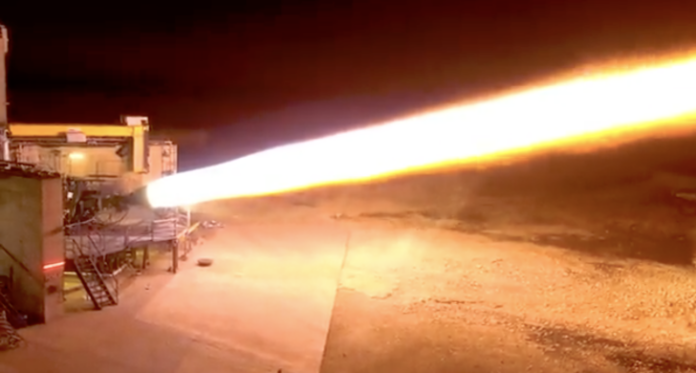
As part of tests for the Artemis program, SpaceX test-fired its Raptore engine last month after chilling its components to simulate temperature at a lunar landing. The Raptor will be the largest engine of its kind fired on the Moon when Starship lands, and footage of the August test released yesterday afternoon comes as SpaceX races to conduct the second flight of its Starship rocket.
The rocket was de-stacked at the company's test site in Boca Chica, Texas, yesterday, and during the same day, SpaceX released test footage of the engine that will fire on the second-stage lunar Starship variant. This vehicle is NASA's first choice regarding plans to develop a human colony on Mars, and former NASA official Kathy Leuders, who now works at SpaceX, also believes that the second Starship test launch can take place as soon as in October.
SpaceX Conducts Multi Second Lunar Raptor Engine Test Fire As Part of Lunar Landing Architecture
The test firing was coordinated with NASA, with the space agency sharing more details about it in a blog post. NASA revealed that SpaceX demonstrated the engine's throttle profile and robust build in 2021. The latest footage shared by SpaceX is for an engine test conducted last month. It focused primarily on the engine's build since the Raptor was chilled to conditions that matched the temperature in a vacuum. Lunar temperatures can drop to as low as negative 130 degrees Celsius, and engines are built of thousands of components whose thermal profile might not withstand extreme conditions.
The Raptor is the star of the Starship program, as most upgrades to the full-stack Starship rocket after SpaceX's April test attempt have involved the engine. However, these have involved powering up 33 engines simultaneously, which is far more complex than firing up the engines of a lunar Starship. SpaceX has run multiple tests of the second stage Starship as well, and it demonstrated the Raptor's lunar descent firing profile to NASA for the first time during this test campaign.
Since 2021 and 2023, SpaceX has also developed a simplified and more powerful version of the Raptor called the Raptor 2. All engines built for months follow the new design, so it's likely that yesterday's test footage also features the Raptor 2.
Cold engines are
!@SpaceX recently conducted a cold start demo of a Raptor Vacuum engine for the @NASAArtemis Starship HLS. This test fired pre-chilled engine hardware simulating in-space thermal conditions for landing on the Moon.
MORE >> https://t.co/k7hqOReocv pic.twitter.com/Tg6B2mWdZB
— NASA Marshall (@NASA_Marshall) September 14, 2023
Last month's chilled Raptor 2 test lasted for a short five seconds and was conducted during the daytime. Five seconds is a small portion of the Starship's full-duration descent profile, which, according to NASA, is slated to last 281 seconds. SpaceX demonstrated this capability in the 2021 test, which had impressed NASA.
SpaceX's general manager for Starbase, Kathy Leuders, who oversees the test, launch and development site, is confident that Starship can conduct its second test flight to orbit next month. Ms. Leuders shared the latest details about SpaceX's work with the FAA to create room for a launch license update to include the second test flight.
SpaceX will not fly until it's ready, shared Leuders, with the installation of the flight termination system being one of the final steps before a rocket can take off. Installation of this system typically also sets a timeframe within which a vehicle must launch.
Raptor engine demonstration of a descent burn to the lunar surface pic.twitter.com/MbW19KFm2H
— SpaceX (@SpaceX) September 14, 2023
According to the SpaceX official:
And so, all this means it that we're doing one more phase to get ready for flight. And so we're looking at, everybody asking again too, what's the date? That's the million dollar question and so we're working through our final stages with our licensing. But honestly also working through, when you got a new vehicle, there's always these last things that you have to protect to make sure you get everything right for that flight. And so we're also working through that too.
As for the current situation with the FAA, she shared:
You know what I, what I really appreciate honestly is it's really tough to make sure that the launch provider is meeting all the rules in the FAA licensing process. There's a new FAA regulation called the FAR Part 4.50, that is fairly new. And one of the things that you recognize when you have a new regulation is we all got to figure out what exactly do all the new parts of that mean.
And so I think the FAA has been a great partner with us, to work with us, and work with our compliance matrix under this new regulation and make sure that we're showing the evidence that we are complying with the regulations that are established to really be able to keep the public safe. So we're in that process now, I think we're in the final kind of process of going to that complained matrix, working the verification.
But the FAA needs to be able to have the time to go through it all that and ensure at the end of the day they also understand enough to say we've done what the U.S. government and the nation has asked us to do. So, we've been obviously meeting every closely together and I'm hoping we that we get this done in the next two to three weeks. But, we just gotta do the work, right, just gotta do the work. I used to always tell everybody, we're not gonna fly until we're ready. It still applies. We're not going to fly until we're ready.
WccftechContinue reading/original-link]




